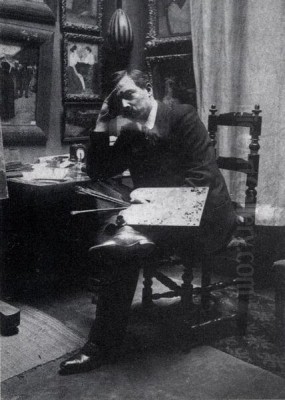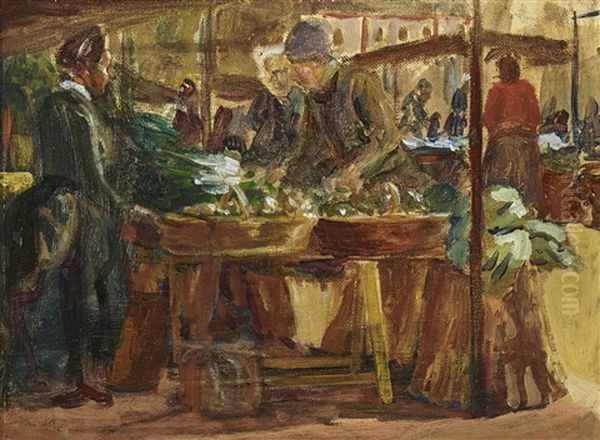
Fernand Piet, a notable French artist active during a pivotal period in art history, navigated the vibrant Parisian art scene from the late 19th century into the mid-20th century. Born in 1869 and passing away in 1942, Piet's life spanned an era of dramatic artistic change. His work reflects the powerful currents of Impressionism and the burgeoning energy of Fauvism, establishing him as a figure whose art absorbed and synthesized key developments of his time.
Early Formation and Influences
Piet's formal artistic education took place in the heart of the French art world, Paris. He honed his skills at the prestigious Beaux-Arts Academy, studying under the tutelage of Eugène Carrière, an artist known for his intimate, atmospheric portraits and scenes. Further enriching his development, Piet frequented the studio of Eugène Cormon. This environment proved particularly fertile, bringing him into close contact with other young artists who would also leave their mark on art history, including the distinctive Henri de Toulouse-Lautrec, the colorful Raoul Dufy, and the expressive Georges Rouault. These early interactions undoubtedly shaped his perspective and technique.
Artistic Development and Style
The core influences shaping Fernand Piet's artistic output were Impressionism and Fauvism. From Impressionism, he likely drew an appreciation for capturing fleeting moments, the effects of light, and scenes of daily life. The impact of Fauvism is evident in his reported use of bold colors, a hallmark of the movement that prioritized expressive color over naturalistic representation. His style is characterized by a combination of delicate brushwork, suggesting a sensitivity to detail and texture, alongside this audacious approach to color. Piet applied this distinctive style to a range of subjects, including landscapes, figural compositions, and still lifes, often achieving a blend that balanced naturalistic observation with a more subjective, expressionistic rendering.
Exhibition Career and Recognition

Piet was an active participant in the Parisian Salon scene, a crucial arena for artists seeking recognition and patronage. He regularly exhibited his works at both the Salons des Artistes Français and the Salons des Indépendants between 1893 and 1925. His involvement with the latter institution deepened significantly in 1905 when he served as its Vice-President alongside the prominent Neo-Impressionist painter Paul Signac. This position underscores his standing within the independent art circles of Paris. Piet's reputation extended beyond France; he participated in the Vienna Secession exhibition in 1899, connecting him with the progressive art movements in Austria. Further recognition came in 1900 when he was awarded a bronze medal at the Paris World Fair, a major international event that showcased achievements in arts and industry.
Notable Works
While a comprehensive catalogue remains elusive based on the provided information, specific works attributed to Fernand Piet offer glimpses into his oeuvre. Two titles mentioned as representative are Railway Crossing and City. Although details like creation dates or current locations for these pieces are not specified in the source material, their titles suggest an engagement with modern life and urban or suburban landscapes, common themes during his era.
More concrete details are available for other works. Der Gemüsehändler (The Vegetable Seller) is identified as an oil painting measuring 20.2 x 27.2 cm, noted as having been exhibited or documented in a Munich publication in 1974. Another piece, Woman in Profile, showcases his skill in drawing, executed using Chinese ink and brush on paper sized 31 x 18.5 cm, and was accompanied by a preparatory sketch. These examples highlight his versatility across different media and subjects.
Contributions to Modern Art
Fernand Piet's career coincided with the rise of modernism, and his work is presented as contributing to the push towards abstraction that characterized early 20th-century art. He is associated with the exploration of abstract art, particularly within the realm of geometric abstraction. His engagement with this avant-garde direction is exemplified by the series Contrastes de formes (Contrasts of Forms), dated to 1913. This series is considered a significant contribution, exploring the relationships between shapes and lines through geometric abstraction, moving away from traditional representational forms to emphasize pure formal qualities. While initially influenced by Impressionism and Fauvism, particularly in his use of color and light, Piet's artistic trajectory reportedly evolved towards a more experimental, abstract style that became uniquely his own, leaving an impact on subsequent modern art movements.
Artistic Relationships and Collaborations
During his time in Paris, Fernand Piet is noted to have established connections with several key figures of the European avant-garde. Among his contemporaries and contacts were artists such as Robert Delaunay, known for his Orphist style; the Surrealist painter Joan Miró; the Dutch pioneer of abstract art Piet Mondrian; and the Dadaist and Surrealist sculptor and painter Hans Arp. These interactions placed Piet within a dynamic network of artists exploring new forms of expression.
His association with these figures sometimes led to collaborative efforts. For instance, Piet is mentioned as having worked with Robert Delaunay on mural decorations for the entrance of the "Les Arts Décoratifs" exhibition in 1925. He also collaborated with Hans Arp, particularly in the context of international art exchanges during the 1920s. Together, they reportedly helped the a.r. group establish an international collection of contemporary art, making it accessible to the public. Further collaboration with Arp is suggested in relation to mural projects in Caracas, indicating an ongoing artistic dialogue. While connections with Piet Mondrian and Joan Miró are mentioned, specific collaborative projects involving Piet with these two artists are not detailed in the provided source material. His involvement with Mondrian might also be contextualized through their shared interest in abstraction and movements like De Stijl, which sought universality through reduced form and color.
Context within the Avant-Garde
The early 20th-century art world was often characterized by intense relationships between artists, involving both camaraderie and rivalry. A famous example is the dynamic between Pablo Picasso and Henri Matisse, whose relationship was marked by mutual observation, artistic dialogue, and a competitive spirit that spurred innovation in both their works. While the source material does not explicitly state that Fernand Piet had a similarly direct competitive relationship with figures like Picasso or Matisse, it acknowledges that such dynamics were common.
Piet's artistic focus, particularly his exploration of form and dynamics influenced by Cubism and his move towards abstraction, differentiated his path. His contributions, including the Contrastes de formes series, situated him firmly within the modernist vanguard, engaging with the formal questions of his time alongside contemporaries like Delaunay, Mondrian, and Arp, even if not in direct competition with the dominant figures of Picasso and Matisse. His work developed along its own lines, contributing to the diverse tapestry of modern art.
A Note on Name Similarity
It is important to distinguish Fernand Piet, the French painter, from a similarly named figure prominent in Dutch culture: "Zwarte Piet" (Black Pete). Zwarte Piet is a traditional character associated with the Sinterklaas (Saint Nicholas) festivities celebrated in the Netherlands and Belgium. Depicted typically in colorful attire with blackface makeup, curly hair, and red lips, the character has become the subject of significant controversy in recent decades.
Critics argue that the Zwarte Piet figure perpetuates racist stereotypes, linking it to colonial history and offensive caricatures of Black people. Defenders of the tradition often argue the blackface represents soot from chimneys, as Zwarte Piet is said to deliver gifts through them, or that it is a harmless tradition without racist intent. However, the debate remains intense, particularly highlighted by anti-racism movements and concerns from immigrant communities regarding cultural sensitivity. Fernand Piet, the artist (1869-1942), has no connection whatsoever to this cultural figure or the surrounding controversy.
Legacy and Collections
Fernand Piet's legacy lies in his position as an artist who bridged the late Impressionist sensibilities with the emerging currents of Fauvism and abstraction. His work reflects the artistic ferment of his time, showcasing a dedication to both traditional subjects and innovative techniques. His participation in major Salons, international exhibitions like the Vienna Secession, and his role within the Salons des Indépendants demonstrate his active engagement with the art world.
According to the source material, works by Fernand Piet are held in various museum collections, potentially including institutions like the Vienna Secession museum, the German National Museum, and the National Art Museum in the United States. The presence of his art in such collections helps ensure its continued visibility and allows for ongoing appreciation of his contribution to French painting during a transformative period in art history. His blend of delicate execution and bold experimentation offers a unique perspective on the transition from 19th-century traditions to 20th-century modernism.